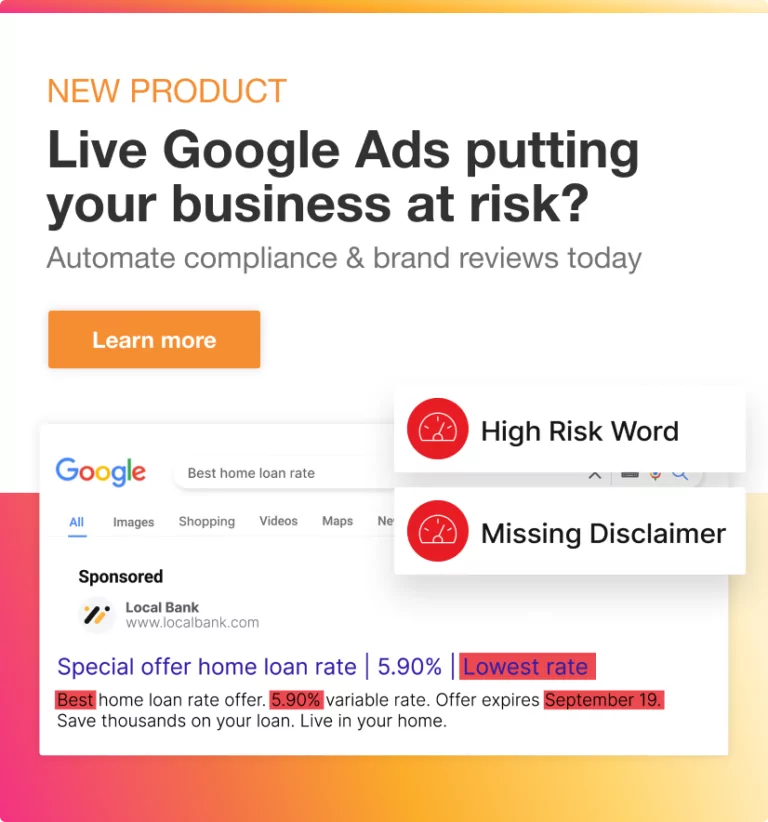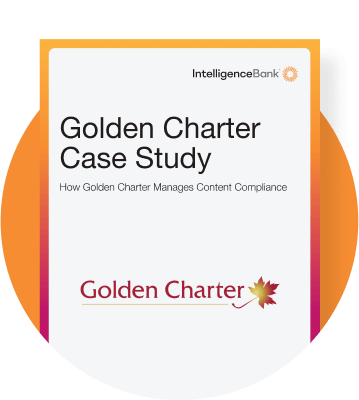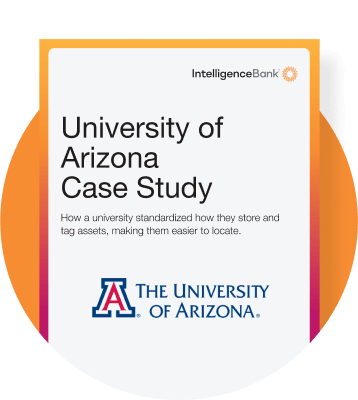For marketers in Australia’s retail banking sector, staying compliant isn’t just about ticking boxes—it’s about safeguarding your brand, avoiding costly penalties, and building trust with your customers. The regulatory landscape is intricate, with multiple laws such as the National Credit Code (NCC), NCCP Act, ASIC Act, Corporations Act, Privacy Act, and SPAM Act shaping how banks communicate with their audiences. Keeping up with these requirements can feel overwhelming, especially when the stakes are high.
This guide will walk you through the essential regulations affecting Australian retail bank marketing, the risks of non-compliance, and how innovative software can simplify the compliance process. Whether it’s crafting a new campaign or reviewing existing materials, understanding these rules is key to ensuring all marketing efforts are both effective and legally sound.
Disclaimer: This document is not intended as a substitute for legal advice. This report has been prepared using both public and private data by IntelligenceBank, a provider of software that helps companies stay on brand and adhere to regulatory compliance. Companies should seek professional legal and regulatory advice when establishing internal compliance protocols.
What Regulations Do Australian Retail Banking Marketers Need to be Across?
In Australia, retail banking marketing is governed by a combination of legislation and regulatory guidelines designed to protect consumers and ensure fair practices. Key laws include:
- National Credit Code (NCC): Sets out requirements for credit-related communications, ensuring transparency and fairness in lending practices.
- NCCP Act (National Consumer Credit Protection Act): Regulates credit activities, including advertising, to ensure consumers are not misled.
- ASIC Act (Australian Securities and Investments Commission Act): Governs financial services advertising, prohibiting misleading or deceptive conduct.
- Corporations Act: Covers financial product disclosures and ensures marketing materials provide accurate and balanced information.
- Privacy Act: Protects customer data and governs how personal information can be used in marketing.
- SPAM Act: Regulates electronic messaging, ensuring customers have consented to receive marketing communications.
These laws work together to create a robust framework that ensures marketing materials are clear, accurate, and fair. However, the complexity of these regulations can make compliance a daunting task.
What are the Risks of Non-Compliance?
Marketing compliance is serious business. Failing to meet these regulatory requirements can have serious consequences for retail banks. Here’s what’s at stake:
Financial Penalties
Regulators like ASIC have the authority to impose significant fines for non-compliance. For example, breaches of the ASIC Act or NCCP Act can result in penalties running into millions of dollars.
Reputational Damage
A publicized compliance failure can erode customer trust and damage your brand’s reputation. In an industry where trust is paramount, this can lead to lost business and long-term harm.
Increased Regulatory Scrutiny
Banks that breach marketing compliance rules may face heightened scrutiny from regulators, including more frequent audits and inspections. This can be both time-consuming and costly.
Legal Action
In severe cases, non-compliance can lead to lawsuits from customers or other stakeholders who feel they were misled or harmed by non-compliant marketing materials.
These risks highlight the importance of getting marketing compliance right. But with so many rules to follow, how can banks ensure their materials meet all requirements without overwhelming their teams?
Challenges of Maintaining Retail Bank Marketing Compliance
Complying with Australian retail banking marketing regulations is no small feat. Here are some of the key challenges banks face:
High Volume of Marketing Content
The demand for marketing materials has skyrocketed, with banks producing everything from digital ads and social media posts to email campaigns and brochures. Each piece of content must be reviewed for compliance, creating a significant workload for legal and compliance teams.
Tight Deadlines
Marketing teams often, (if not always), operate under tight deadlines, with campaigns needing to be launched quickly to capitalize on market opportunities. The increase in digital marketing spend is also a large factor driving continually shortening material deadlines. This can lead to rushed compliance reviews, increasing the risk of errors.
Resource Constraints
Many banks are operating with lean compliance teams, making it difficult to keep up with the volume of materials requiring review. This can create bottlenecks and slow down campaign timelines.
Complex and Evolving Regulations
The rules governing marketing compliance are not only complex but also subject to change. Keeping up with updates to the NCC, ASIC Act, and other legislation requires constant vigilance.
Inconsistent Interpretation
Different reviewers may interpret compliance requirements differently, leading to inconsistencies in how rules are applied across materials. This can result in delays and confusion.
Repetitive Review Processes
Compliance reviews often involve repetitive tasks, such as checking for balanced presentations, verifying performance data, and ensuring proper disclosures. These tasks can be time-consuming and tedious for reviewers.
How Automation Can Simplify Compliance
The good news? Many of these challenges can be addressed through automation.
In fact, amalgamated IntelligenceBank research for clients shows that over 75% of comments on marketing content made by Legal or Compliance teams relates to errors such as incorrect claims, and missing or incorrect disclaimers. They are the type of comments that AI can deal with on the spot and lift a large part of the burden for Compliance teams. Here is a snapshot of of the results:
- 17% of comments relate to brand compliance issues: These focused on things like brand name usage, logo issues, font sizes, tone, and readability.
- 38% of comments relate to legal and compliance issues: Common concerns included outdated disclaimers, inaccurate claims, missing disclosures, and specific legal language requests.
- 22% of comments are about wording: This includes phrasing issues around claims and product disclosures, rather than basic spelling and grammar.
- 23% of comments required direct human intervention, where nuance or specific context was needed.
By leveraging AI-powered tools, banks can streamline the compliance review process, reduce the risk of errors, and ensure consistency across all marketing materials.
How It Works:
- Create Risk Rules: IntelligenceBank offers a range of pre-existing rules tailored to specific legislation by industry and location, including packages tailored to Australian retail banking regulations. These rules cover key requirements under the NCC, ASIC Act, Privacy Act, and other relevant legislation. They can be totally customized or expanded to fit your organization’s compliance or business needs.
- Real-Time Reviews: Marketing content is automatically reviewed, flagging potential compliance issues before they become problems.
- Keep a Record: The platform automatically maintains records of all comments made on PDFs, artwork and images etc. so they can easily be referred to down the line.
Benefits of Automating Compliance Reviews
Automation offers a range of benefits that can transform the way Australian retail banks approach marketing compliance.
One of the most significant advantages is faster turnaround times which impacts the bottom line on several levels. By streamlining the compliance review process, automation allows marketing teams to move campaigns from concept to launch more quickly, ensuring they can respond to market opportunities without unnecessary delays. It can also save a significant amount of time. Predicted savings can be estimated via the Content and Web Risk Reviews Cost Savings Calculator.
Additionally, automated reviews help bring consistency across materials by applying the same standards to every piece of content. This eliminates the risk of inconsistent interpretations of compliance rules, which can often arise when multiple reviewers are involved.
Another key benefit is the reduced risk of errors. By automating repetitive tasks, such as verifying required disclosures or checking for balanced presentations, banks can minimize the likelihood of human error, which is especially critical when dealing with complex regulatory requirements.
Automated compliance review software also provides scalability, enabling banks to handle large volumes of marketing content efficiently. This is particularly important given the manic content cycle modern marketers are often faced with.
Lastly, automation fosters improved collaboration across teams. With a centralized platform, marketing, legal, and compliance teams can work together more effectively, reducing delays and miscommunication while ensuring everyone is aligned on compliance goals. Together, these benefits not only enhance efficiency but also strengthen the overall integrity of a bank’s marketing efforts.
Key Compliance Checklists for Australian Retail Bank Marketing
IntelligenceBank’s Australian Retail Bank Marketing compliance review software includes 74 best practice rules based on key regulations and legislation. To give you a sense of the nature of content it hunts for, here’s a simplified checklist of some key compliance requirements:
1. Balanced Presentations
- Ensure marketing materials present both the benefits and risks of a product or service.
- Avoid exaggerated or unsubstantiated claims.
2. Accurate Disclosures
- Include all required disclosures, such as privacy, property valuations, fees, terms, and conditions.
- Ensure disclosures are clear and prominently displayed.
3. Third-Party Information
- Properly attribute any third-party data or quotes used in marketing materials.
4. Testimonials and Endorsements
- Ensure testimonials are genuine and have the necessary permissions.
5. Layout Considerations
- Important financial information must be on the same page and has to meet visibility benchmarks.
Why Existing Rule Lists Work
While IntelligenceBank does offer completely bespoke automated compliance solutions, industry-based rule packages are a great solution as they are completely aligned to the legislation and regulations that exist in the sector. Additionally, they can also be added to and adjusted to suit your company’s needs.
It’s the sweet spot between building review software completely from scratch – which can take weeks – or opting for a customizable pre-built compliance solution that will address the unique needs of Australian retail banks.
Ready to Simplify Your Compliance Process?
Upholding Australian retail banking marketing compliance doesn’t have to be a headache. With the right software and processes in place, you can ensure your marketing materials are compliant, accurate, and effective.
IntelligenceBank’s automated compliance solutions are designed to help banks like yours stay on top of regulatory requirements while saving time and reducing risk.
It’s a great way to get up and running fast knowing that what the regulators are looking for are the same things the software is pre-programmed to catch.
Contact us today to learn more or book a demo.




